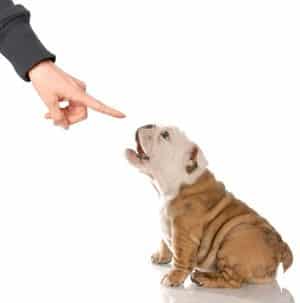DOG TRAINING CORRECTIONS
by Will Bangura, Dog Behaviorist and CEO of Phoenix Dog Training in Phoenix Arizona
We all have had dogs that displayed behaviors that we did not like. Additionally, we have all struggled from time to time with a dog that perhaps we labeled “stubborn.” If you have ever had a dog where dog training corrections did not seem to work, then this article might be for you and your dog.

At my dog training company, Phoenix Dog Training we work with dogs that have severe behavior problems. Some behavior problems may have been going on for years with little change in behavior.
One of the first questions I ask dog owners is, “How do you correct the dog?” Often time the answer I get is, “I tell him no.” My next statement to the dog owner is, “how did that work for you?” The answer I usually get is, “he just doesn’t care, he just doesn’t get it.”
Communicating to your dog that it has engaged in a behavior you do not want involves having very regular, very consistent, very clear communication with your dog.
If you let your dog get away with a behavior that you don’t like sometimes and other times you correct it, the dog will be confused and will never learn to stop the unwanted behavior. You must be consistent. Correct every unwanted behavior in the act. If you are not available to correct a behavior because you are gone, asleep, or too busy with another task that you can’t keep your eyes on your dog, you need to crate or confine your dog. Failure to confine a dog with behavior problems that engages in those unwanted behaviors when you are not looking or not home, will result in total failure. In this scenario the dog would be corrected some times, but other times would get away with the behavior. For example, a dog who likes to counter surf can steal items off the counter. if your not home your dog could counter surf and there would be no consequence. This ends up being unclear communication, poor consistency, and communication that is anything from clear. Sometimes the dog gets corrected, other times it does not.
GUIDELINES FOR DOG TRAINING CORRECTIONS
- Be consistent
- Be clear in your communication
- Be sure the correction is something your dog find unpleasant
- Be sure training is regular and has a lot of repetition
- Be sure its a correction and not an interruption
- Be sure to work proactively and not just reactively
I have discussed the need for consistency and to have clear communication. We need to discuss what a correction is and what it is not. A correction is not a correction because you say it is or because you think it is. Correction is just a nicer way of saying punishment. Everyone hates the word punishment, but if you understand the science of how dogs think, learn, and process information, as well as how behaviors are changed, you will understand that there are only two things that are at work here in changing behavior. There are reinforcers, and there are punishers. Recently I was working with a client and doing some dog training in Scottsdale Arizona and the topic of corrections came up. The client stated that, “I read that giving dogs corrections are told school dog training and are archaic training methods. She went on to say, “you can train any dog to do anything with positive reinforcement.” What the dog owner was referring to is the lie that is being told by total positive reinforcement trainers and most behaviorists in the country.
Ask any dog owner with a high prey drive dog how trying to stop their dog from chasing rabbits and running across the street with the danger of being hit by a car is working using just positive reinforcement. It does not happen in the real world with real world distractions. There is always going to be a distraction in the world that has more value to your dog than any food reward or any positive reinforcer. Its not a matter of if, but when. You dog looks at the rabbit, then looks at the treat. In the dog’s mind the treat is worth five bucks $5, but the rabbit is worth one hundred bucks $100. See Ya later, and off goes the chase.
Punishers, or corrections should not and do not need to cause fear, pain, or intimidations. That is just plain cruel and inhuman. However, there is nothing wrong with giving a loud NO that the dog finds unpleasant, or a mild leash and collar correction the dog finds unpleasant. You have to temper your correction to the temperament of the dog.
Some dogs have a very soft temperament and you barely look at them and the fall apart; other dogs have a very hard temperament and you could be very firm with them and they are not phased, they think it is fun and a game. One dog will get a very mild correction, the other dog would need a much firmer correction.
PROACTIVE DOG TRAINING CORRECTIONS VERSUS REACTIVE
Now is the time to talk about the difference between interrupting a behavior or correcting a behavior. I had this discussion with one of my Mesa Dog Training clients and asked her, “are you just interrupting the behavior or correcting the behavior?” She was telling her dog NO when it would jump on her. But it was clear that as far as the dog was concerned the owners quiet and meek verbalization of NO got the dog’s attention and interrupted the jumping for a second, but then the dog jumped up on her anyway. Interruptions are corrections that are too mild. The dog does not care and will keep on jumping. A correction is unpleasant and the dog will not jump right after a correction. The dog learned jumping on the owner brings unpleasant consequences.
Changing any behavior requires a lot of repetition. Most dog owners are only reactively correcting or training their dogs versus being proactive in correcting unwanted behaviors. Some dogs will only engage in an unwanted behavior on occasion. For example, maybe you only leave food on the counter occasionally, and therefore the dog counter surfs occasionally. This will most likely not extinguish the unwanted behavior because perhaps it only happens twice a month, but twice a month is too much if the dog is eating tonight’s dinner off the counter.
PROACTIVE DOG TRAINING VERSUS REACTIVE DOG TRAINING CORRECTIONS
At my dog training company we teach dog owners to proactively train on unwanted behaviors daily. We teach them that we can stop unwanted behaviors 5 times faster by creating the opportunity or “baiting” the dogs behavior so we have more repetition is a short enough period of time for learning and conditioning to happen. With dogs it is better to think in term of conditioning rather than learning. You and I can learn right away don’t cross the street when there is traffic. All you have to do is tell us or show us once. That does not work for a dog. They have to be conditioned again and again and again, until it becomes so well conditioned that it is muscle memory. As a result, there is a need to proactively train.
I tell my dog training clients to take about two minutes a day to set your dog up for training out unwanted behaviors. Lets go back to the counter surfing example. In this case we would set the dog up daily with food on the counter and maybe even some food hanging off the counter. When the dog shows interest we correct with a firm no. Then we bring the dog back in close to the counter. If the dog shows interest we give a second correction. If the dog shows no interest we reward with high value food rewards.
We are proactively teaching the dog that interest in food on the counter brings about some unpleasant consequence and that ignoring the food on the counter get a yummy food reward. We do this for two minutes every day for as long as it takes to get a dog to consistently not take the bait for a week or two. For more stubborn problems we condition longer.
I challenge you to add proactive behavior training to see how quickly you can stop your dog’s unwanted behaviors.

